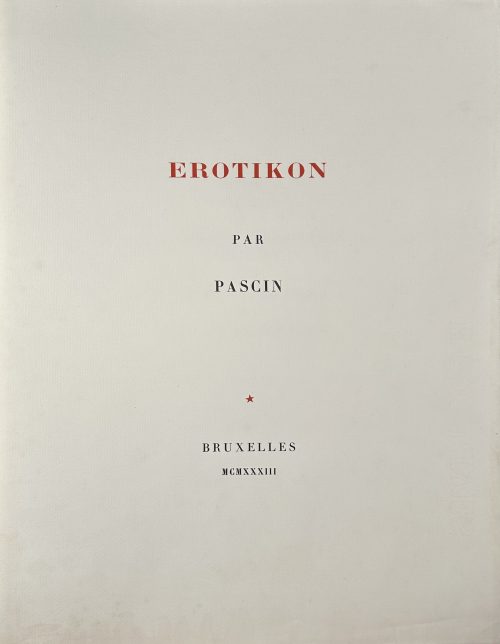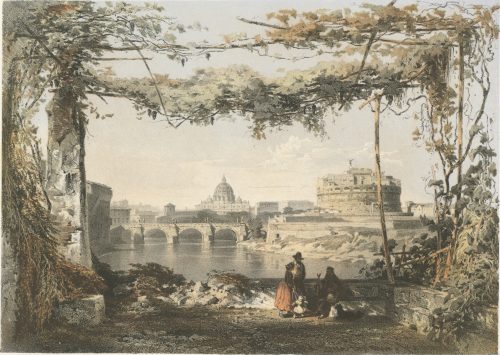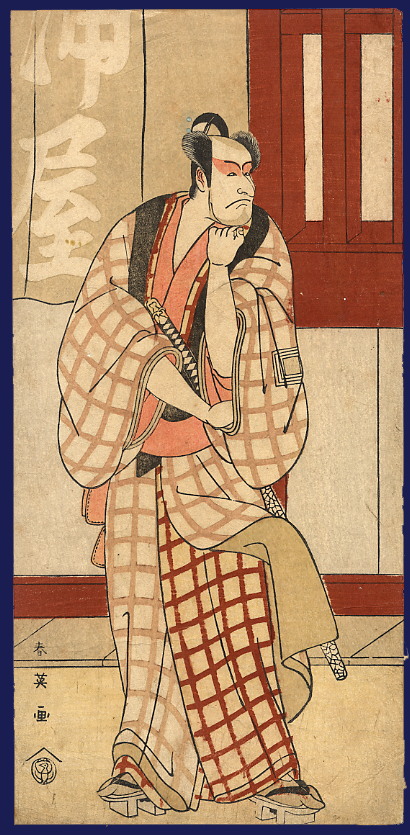-
 A portfolio of nine heliogravures after Jules Pascin. Cloth-backed cardboard portfolio 420 x 335 mm with 9 heliogravures on slightly tinted india paper, each numbered in pencil and mounted into a passe-partout 410 x 318 mm. Copy № 25 out of 40 printed on india (chine) paper. Copy № 25 of 40. Title (red and black): EROTIKON | PAR | PASCIN | ★ | BRUXELLES | MCMXXXIII || Limitation: CET | ALBUM | A ÉTÉ TIRÉ | A | QUARANTE ET UN EXEMPLAIRES | NUMÉROTÉS | DONT | UN EX. SUR PAPIER ANCIEN | & | QUARANTE EX. SUR CHINE | No (ms 25/40) || Catalogue raisonné: Dutel III № 1498. Seller's description:Neun Heliogravüren. 1933. Meist ca. 30 : 35 cm. Nummeriert. Exemplar 25/40 (Gesamtauflage 41). – Die Heliogravüren auf leicht getöntem China, jedes Blatt mit Bleistift nummeriert und in Passepartouts montiert. – Die neun Passepartouts eingelegt in zwei Büttenumschläge, einer mit Titel und dem nummerierten Auflagenvermerk, der zweite unbedruckt, ferner Büttenumschlag mit Titel in Rotdruck und Halbleinenchemise. – Die Heliogravüren erschienen 1933, drei Jahre nach Pascins Tod bei Daragnes in Paris mit der fingierten Angabe »Brüssel«. – Das berühmte Mappenwerk bildet eine der großen Seltenheiten der erotischen Kunst. Die Motive Pascins beschreibt das Bilderlexikon als »eine Art ›Boheme-Rokoko im Montmartre-Milieu‹« und lobt den Künstler: »Er ist ein außerordentlicher Zeichner, der es versteht, bei allem Zynismus, der seinen exhibitionistischen Charakter nicht verleugnet, auf diesem Kulturdünger eine neuartige Blume voll graziöser Schönheit erblühen zu lassen.« Mappe: 42 : 33,5 cm. – Der äußere Büttenumschlag mit leichtem Wasserrand. – Zwei Heliogravüren minimal stockfleckig, sonst tadellos und absolut vollständig. Dutel 1498 (mit Auflagenvarianten). – Der kalte Blick S. 198ff. – Bilderlexikon II, 718.
A portfolio of nine heliogravures after Jules Pascin. Cloth-backed cardboard portfolio 420 x 335 mm with 9 heliogravures on slightly tinted india paper, each numbered in pencil and mounted into a passe-partout 410 x 318 mm. Copy № 25 out of 40 printed on india (chine) paper. Copy № 25 of 40. Title (red and black): EROTIKON | PAR | PASCIN | ★ | BRUXELLES | MCMXXXIII || Limitation: CET | ALBUM | A ÉTÉ TIRÉ | A | QUARANTE ET UN EXEMPLAIRES | NUMÉROTÉS | DONT | UN EX. SUR PAPIER ANCIEN | & | QUARANTE EX. SUR CHINE | No (ms 25/40) || Catalogue raisonné: Dutel III № 1498. Seller's description:Neun Heliogravüren. 1933. Meist ca. 30 : 35 cm. Nummeriert. Exemplar 25/40 (Gesamtauflage 41). – Die Heliogravüren auf leicht getöntem China, jedes Blatt mit Bleistift nummeriert und in Passepartouts montiert. – Die neun Passepartouts eingelegt in zwei Büttenumschläge, einer mit Titel und dem nummerierten Auflagenvermerk, der zweite unbedruckt, ferner Büttenumschlag mit Titel in Rotdruck und Halbleinenchemise. – Die Heliogravüren erschienen 1933, drei Jahre nach Pascins Tod bei Daragnes in Paris mit der fingierten Angabe »Brüssel«. – Das berühmte Mappenwerk bildet eine der großen Seltenheiten der erotischen Kunst. Die Motive Pascins beschreibt das Bilderlexikon als »eine Art ›Boheme-Rokoko im Montmartre-Milieu‹« und lobt den Künstler: »Er ist ein außerordentlicher Zeichner, der es versteht, bei allem Zynismus, der seinen exhibitionistischen Charakter nicht verleugnet, auf diesem Kulturdünger eine neuartige Blume voll graziöser Schönheit erblühen zu lassen.« Mappe: 42 : 33,5 cm. – Der äußere Büttenumschlag mit leichtem Wasserrand. – Zwei Heliogravüren minimal stockfleckig, sonst tadellos und absolut vollständig. Dutel 1498 (mit Auflagenvarianten). – Der kalte Blick S. 198ff. – Bilderlexikon II, 718. -

Sheet № 20 from the series of 42 сhromolithography prints 'Skizzen und Bilder aus ROM und der Umgegend' (Sketches and pictures from Rome and surroundings).
Inscriptions:
Top left: LINDEMANN-FROMMEL’S Top right: Skizzen und Bilder aus ROM und der Umgegend. Centre below: No 20 | IL CASTEL E IL PONTE SANT ANGELO, | E SAN PIETRO. Bottom left: Imp. de JACOMME et Cie. R. de Lancry, 16 Paris. Bottom centre: Stuttgart, bei FRANZ KÖHLER. Bottom right: Paris, Goupil et Cie. Editeurs.Dimensions:
Plate: 372 x 473 mm Sheet: 372 x 473 mm
Contributors:
Lindemann-Frommel, Karl (French-German, 1819 – 1891) – artist. Jacomme, Claude (French, fl. 1838 – 1857) – printer/lithographer. Goupil et Cie (Paris); Goupil, Adophe (French, 1806 – 1893) – publisher Franz Köhler (Stuttgart); Köhler, Franz (German, 1805 – 1872) – publisher. -
 An unsigned print, presumably by Katsukawa Shunshō that presumably depicts a kabuki actor Ichikawa Monnosuke II. I was not able to find any reference of the image. Size: Hosoban. According to The actor's image. Print makers of the Katsukawa School. Timothy T. Clark and Osamu Ueda with Donald Jenkins. Naomi Noble Richard, editor The Art Institute of Chicago in association with Princeton University Press, 1994, Ichikawa Monnosuke II was born in 1743, in Ōji Takinogawa, Edo. He died on October 19, 1974. His specialities were young male roles (wakashu) and male leads (tachi yaku). He was considered to be one of the four best young actors of his day.
An unsigned print, presumably by Katsukawa Shunshō that presumably depicts a kabuki actor Ichikawa Monnosuke II. I was not able to find any reference of the image. Size: Hosoban. According to The actor's image. Print makers of the Katsukawa School. Timothy T. Clark and Osamu Ueda with Donald Jenkins. Naomi Noble Richard, editor The Art Institute of Chicago in association with Princeton University Press, 1994, Ichikawa Monnosuke II was born in 1743, in Ōji Takinogawa, Edo. He died on October 19, 1974. His specialities were young male roles (wakashu) and male leads (tachi yaku). He was considered to be one of the four best young actors of his day. -
 Katsukawa Shun'ei. Signed: Shun'ei ga (春英画). Vertical Ōban. No reference whatsoever. Unidentified play, actors, roles, year, theatre. SOLD
Katsukawa Shun'ei. Signed: Shun'ei ga (春英画). Vertical Ōban. No reference whatsoever. Unidentified play, actors, roles, year, theatre. SOLD -
 Print by Katsukawa Shun'ei that presumably depicts a kabuki actor Ichikawa Monnosuke II. I was not able to find any reference of the image. Size: Hosoban. SOLD
Print by Katsukawa Shun'ei that presumably depicts a kabuki actor Ichikawa Monnosuke II. I was not able to find any reference of the image. Size: Hosoban. SOLD -
 Katsukawa Shun'ei (勝川 春英; 1762 – 1819).TITLE: Sawamura Sôjûrô III as Kakogawa Honzô.SERIES: Kanadehon Chūshingura (Kana practice book: Treasury of the loyal retainers").DATE: 1795Signed: Shun'ei ga (春英画). Publisher: Iwatoya Kisaburō, Marks 173/p.169. Vertical Ōban: 14.75 x 9.625 inchOn 4th lunar month of 1795 Sôjûrô plays the roles of En'ya Hangan and Kakogawa Honzô in the drama "Kanadehon Chûshingura" at Miyakoza theater in Edo.
Katsukawa Shun'ei (勝川 春英; 1762 – 1819).TITLE: Sawamura Sôjûrô III as Kakogawa Honzô.SERIES: Kanadehon Chūshingura (Kana practice book: Treasury of the loyal retainers").DATE: 1795Signed: Shun'ei ga (春英画). Publisher: Iwatoya Kisaburō, Marks 173/p.169. Vertical Ōban: 14.75 x 9.625 inchOn 4th lunar month of 1795 Sôjûrô plays the roles of En'ya Hangan and Kakogawa Honzô in the drama "Kanadehon Chûshingura" at Miyakoza theater in Edo. -
 Katsukawa Shun'ei. The Sumo Bout between Yotsuguruma (right) and Yamaoroshi (left). Date: 1800 or 1805/06. Similar sheet can be found at Edo Tokyo Museum. Size: Vertical Ōban. Sumo wrestler Yotsuguruma Daihachi (1772 - 1809) first appeared in the records of national tournaments in winter of 1794. Then he lost 3 matches and won zero. He first won in the spring tournament of 1797 in a match against maegashira (the fifth-highest rank of sumo wrestlers) named Kougamine. Yamaoroshi Gengo (born 1762) came in at the winter tournament of 1799 . He was much more successful in his career than Yotsuguruma, but he had never won a tournament. It was the time of great Raiden, who won most of them. In the spring tournament of 1800 Yotsuguruma and Yamaoroshi fought against each other for the first time. Yotsuguruma lost. The next time they met on the ring was at the winter tournament of 1805, and again in 1806. Both matches were won by Yamaoroshi. Yamaoroshi retired in 1809; Yotsuguruma died in 1809.
Katsukawa Shun'ei. The Sumo Bout between Yotsuguruma (right) and Yamaoroshi (left). Date: 1800 or 1805/06. Similar sheet can be found at Edo Tokyo Museum. Size: Vertical Ōban. Sumo wrestler Yotsuguruma Daihachi (1772 - 1809) first appeared in the records of national tournaments in winter of 1794. Then he lost 3 matches and won zero. He first won in the spring tournament of 1797 in a match against maegashira (the fifth-highest rank of sumo wrestlers) named Kougamine. Yamaoroshi Gengo (born 1762) came in at the winter tournament of 1799 . He was much more successful in his career than Yotsuguruma, but he had never won a tournament. It was the time of great Raiden, who won most of them. In the spring tournament of 1800 Yotsuguruma and Yamaoroshi fought against each other for the first time. Yotsuguruma lost. The next time they met on the ring was at the winter tournament of 1805, and again in 1806. Both matches were won by Yamaoroshi. Yamaoroshi retired in 1809; Yotsuguruma died in 1809. -
 Artist: Katsukawa Shunkō [勝川 春好] (Japanese, 1743 – 1812).
Artist: Katsukawa Shunkō [勝川 春好] (Japanese, 1743 – 1812).Actor: Matsumoto Kōshirō IV [[松本幸四郎]; other names: Omegawa Kyōjūrō, Ichikawa Komazō II, Ichikawa Somegorô I, Ichikawa Takejūrō, Segawa Kinji, Segawa Kingo] (Japanese, 1737 – 1802).
Signed: Shunkō ga. Size: Hosoban; 14 x 33 cm. SOLD -
 Ichikawa Ebizō III (Matsumoto Kōshirō II, Ichikawa Danjūrō IV, 1711-1778) probably shown as Shinozuka Gorō in the Shibaraku scene of the play Ōyoroi Ebidō Shinozuka, performed at the Nakamura Theater in the 11th month of 1772 (Meiwa 9). This was the occasion when he celebrated his name change, from Matsumoto Kōshirō II to Ichikawa Ebizō III. The lobster or giant shrimp (ebi) upon the Ichikawa family crest (three concentric squares - three measures of rice) on his garment underscores the fact of the name change (ebizō).
Ichikawa Ebizō III (Matsumoto Kōshirō II, Ichikawa Danjūrō IV, 1711-1778) probably shown as Shinozuka Gorō in the Shibaraku scene of the play Ōyoroi Ebidō Shinozuka, performed at the Nakamura Theater in the 11th month of 1772 (Meiwa 9). This was the occasion when he celebrated his name change, from Matsumoto Kōshirō II to Ichikawa Ebizō III. The lobster or giant shrimp (ebi) upon the Ichikawa family crest (three concentric squares - three measures of rice) on his garment underscores the fact of the name change (ebizō). -
 Katsukawa Shunshō ( 勝川 春章; 1726 – 19 January 1793).
Katsukawa Shunshō ( 勝川 春章; 1726 – 19 January 1793).SIZE: 12.5 x 5.75 in.
-
 Katsukawa Shunshō ( 勝川 春章; 1726 – 19 January 1793).
Katsukawa Shunshō ( 勝川 春章; 1726 – 19 January 1793).Signed: Shunchô ga (春潮画); Censor's seal: kiwame (改印:極)
Publisher: Iwatoya Kisaburō (Eirindō); c. 1760s – 1832. Marks #173/p.169.
Reference: MFA ACCESSION NUMBER 11.21263. Not in Pins.
Act VII, Gion Ichiriki no ba ("The Ichiriki Teahouse at Gion") This act gives a taste of the bustling atmosphere of the Gion pleasure quarter in Kyoto. Yuranosuke is feigning a life of debauchery at the same teahouse to which Okaru has been indentured. Kudayū, the father of Sadakurō, arrives. He is now working for Moronō and his purpose is to discover whether Yuranosuke still plans revenge or not. He tests Yuranosuke's resolve by offering him food on the anniversary of their lord's death when he should be fasting. Yuranosuke is forced to accept. Yuranosuke's sword – the revered symbol of a samurai – is also found to be covered in rust. It would appear that Yuranosuke has no thoughts of revenge. But still unsure, Kudayū hides under the veranda. Now believing himself alone, Yuranosuke begins to read a secret letter scroll about preparations for the vendetta. On a higher balcony Okaru comes out to cool herself in the evening breeze and, noticing Yuranosuke close by, she also reads the letter reflected in her mirror. As Yuranosuke unrolls the scroll, Kudayū, too, examines the end which trails below the veranda. Suddenly, one of Okaru's hairpins drops to the floor and a shocked Yuranosuke quickly rolls up the scroll. Finding the end of the letter torn off, he realises that yet another person knows his secret and he must silence them both. Feigning merriment, he calls Okaru to come down and offers to buy out her contract. He goes off supposedly to fix the deal. Then Okaru's brother Heiemon enters and, hearing what has just happened, realises that Yuranosuke actually intends to keep her quiet by killing her. He persuades Okaru to let him kill her instead so as to save their honour and she agrees. Overhearing everything, Yuranosuke is now convinced of the pair's loyalty and stops them. He gives Okaru a sword and, guiding her hand, thrusts it through the floorboards to kill Kudayū. The main actor has to convey a wide variety of emotions between a fallen, drunkard rōnin and someone who in reality is quite different since he is only faking his weakness. This is called hara-gei or "belly acting", which means he has to perform from within to change characters. It is technically difficult to perform and takes a long time to learn, but once mastered the audience takes up on the actor's emotion. Emotions are also expressed through the colours of the costumes, a key element in kabuki. Gaudy and strong colours can convey foolish or joyful emotions, whereas severe or muted colours convey seriousness and focus. -
 Katsukawa Shunshō ( 勝川 春章; 1726 – 19 January 1793).
Katsukawa Shunshō ( 勝川 春章; 1726 – 19 January 1793).Signed: Katsukawa Shunshô ga (勝川春章画).
The size is somewhat larger than the standard pillar print (hashira-e): 16.3 x 67.7 cm.
No references found so far.
-
 The Seven Gods of Good Luck in the Takarabune (ship of fortune) with a crane (the phoenix) above them.
The Seven Gods of Good Luck in the Takarabune (ship of fortune) with a crane (the phoenix) above them.Attributed to Katsukawa Shunshō, fl. 1726–92. Publisher: Uemura from Shiba (Edo). Marks "Publishers": U361|25-300: Uemura han (1793-1813). Marks "Artists, publishers...": Emiya Kichiemon (1688-1835). Artist signature absent. Looks very much like Pins #565 [p.223], but NOT the same. This exact design has not been found anywhere.

-
 Kikukawa Eizan (菊川 英山, 1787 – July 17, 1867) Signed: Eizan hitsu (英山筆)
Kikukawa Eizan (菊川 英山, 1787 – July 17, 1867) Signed: Eizan hitsu (英山筆)Jacob Pins #972/p.341. Leiden, Rijksmuseum voor Volkenkunde.
"The Lovers Miura-ya Komurasaki and Shirai Gonpachi: Tragic love stories taken from real life and dramatized were a staple of stage and print; the darkly romantic combination of desire and death was hugely popular in the eighteenth century. Hirai Gompachi was a warrior of the Tottori fief in western Japan who fled to Edo after committing a murder. He was apprehended and sentenced to death in 1679. His distraught lover, the courtesan Komurasaki, committed suicide at his grave." [MET]
.
-

Kitagawa Tsukimaro (Kikumaro): 喜多川 月麿, fl. c. 1794–1836.
Mother is playing with her child: they left playing with shadow lantern for freeing a turtle (Hojo-e, or "Rite for the Release of Living Beings").Signed: Tsukimaro hitsu (月麿筆); Publisher's mark; censor's seal: Kiwame + Yamaguchiya Tôbei gyōji seal (1811-14).
-
 Kitagawa Utamaro (喜多川 歌麿; c. 1753 – 31 October 1806). Act III (Sandanme), from the series The Storehouse of Loyal Retainers (Chûshingura). Publisher Nishimuraya Yohachi (Eijudô). About 1801–02 (Kyôwa 1–2) Vertical ôban; 39.3 x 26 cm (15 1/2 x 10 1/4 in.). Reference: MFA ACCESSION NUMBER 11.14441 Ukiyo-e shûka 3 (1978), list #368.3; Shibui, Ukiyo-e zuten Utamaro (1964), 165.1.3; the series: Asano and Clark 1995, #s 383-5.
Kitagawa Utamaro (喜多川 歌麿; c. 1753 – 31 October 1806). Act III (Sandanme), from the series The Storehouse of Loyal Retainers (Chûshingura). Publisher Nishimuraya Yohachi (Eijudô). About 1801–02 (Kyôwa 1–2) Vertical ôban; 39.3 x 26 cm (15 1/2 x 10 1/4 in.). Reference: MFA ACCESSION NUMBER 11.14441 Ukiyo-e shûka 3 (1978), list #368.3; Shibui, Ukiyo-e zuten Utamaro (1964), 165.1.3; the series: Asano and Clark 1995, #s 383-5. -
 Kitagawa Utamaro. According to Chris Uhlenberg this is an illustration from the book Ehon koi no Onamaki, 3 vols, published in Kansei 11 (1799). Illustrated in b/w in: Hayashi Yoshikazu: Kitagawa Utamaro, in the series: Edo makura-e shi shusei, published in 1990, reissued 1994. Size: Chuban (25.5 x 18.5 cm), two book pages glued together.
Kitagawa Utamaro. According to Chris Uhlenberg this is an illustration from the book Ehon koi no Onamaki, 3 vols, published in Kansei 11 (1799). Illustrated in b/w in: Hayashi Yoshikazu: Kitagawa Utamaro, in the series: Edo makura-e shi shusei, published in 1990, reissued 1994. Size: Chuban (25.5 x 18.5 cm), two book pages glued together. -
 Kitagawa Utamaro. Illustration from book Ehon koi no Onamaki, published in 1799. Reference found by Chris Uhlenbeck: he found one of the designs in Hayashi Yoshikazu's 20-volume set Edo makura-e shi shusei: Kitagawa Utamaro. Size: Chuban (25.5 x 18.5 cm), two book pages glued together.
Kitagawa Utamaro. Illustration from book Ehon koi no Onamaki, published in 1799. Reference found by Chris Uhlenbeck: he found one of the designs in Hayashi Yoshikazu's 20-volume set Edo makura-e shi shusei: Kitagawa Utamaro. Size: Chuban (25.5 x 18.5 cm), two book pages glued together.


